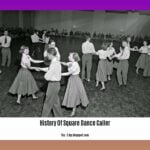Embark on a fascinating journey into the world of square dance with “Facts About Square Dance: Unveiling the Allure of this Captivating Dance Form.” Discover the rich history, intricate rules, and captivating techniques that define this beloved dance style. Let renowned square dance callers and performers guide you through its complexities, making the art form accessible and engaging for all.
Key Takeaways:
- Square dancing is a lively dance for four couples arranged in a square.
- It originated in England in the 16th century and was brought to America by settlers.
- Different styles of square dancing exist, such as traditional, modern Western, and contemporary.
- Live music, often including fiddles and banjos, accompanies square dances.
- Square dancing is associated with Western American culture and is the official dance of 19 U.S. states.
- It evolved from European folk dances like the Morris Dance and quadrille.
Facts About Square Dance

Originating in 16th-century England, square dance has gracefully woven its way into the fabric of global dance culture. Here are some captivating facts about square dance that will leave you tapping your feet:
Structured Formation: Square dance is a structured dance performed by four couples arranged in a square, facing the center.
Global Appeal: Square dance has captivated hearts across the globe, with variations found in countries such as the United States, Canada, and Europe.
Historical Roots: Square dance finds its origins in European folk dances, such as the Morris Dance and quadrille.
19th-Century Surge: In the 19th century, square dance gained immense popularity in the United States, becoming interwoven with the country’s cultural heritage.
Diverse Styles: Square dance encompasses various styles, including traditional, modern Western, and contemporary, each with unique characteristics and regional influences.
Musical Accompaniment: Live music, typically featuring fiddles and banjos, provides a lively and spirited atmosphere for square dances.
Cultural Symbol: Square dance holds a special place in American culture, serving as the official dance of 19 U.S. states.
Evolution Over Time: Square dance has undergone constant evolution, adapting to changing tastes and social trends while preserving its core elements.
Community Aspect: Square dance fosters a sense of community, bringing people together through shared experiences and a passion for dance.
Health Benefits: Engaging in square dance offers both physical and mental benefits, promoting coordination, cardiovascular health, and cognitive function.
Discover the rich tapestry of square dancing through the ages in our comprehensive guide to its history.
Step behind the scenes and uncover the fascinating history of square dance callers, who guide dancers through intricate steps.
Explore the evolution of square dancing in schools, where it has nurtured teamwork and cultural appreciation.
Delve into the brief history of square dancing to trace its humble beginnings and its transformative journey.
Embark on a geographic exploration in our article on where square dance originated, uncovering its global roots.
Unravel the captivating origin of square dancing, tracing its evolution from ancient rituals to modern-day entertainment.
Different types of square dance calls

In the lively world of square dancing, different types of square dance calls orchestrate the intricate dance moves. These calls, issued by a skilled caller, guide dancers through a sequence of steps and figures, creating a tapestry of movement and camaraderie.
Basic Calls: The Foundation
- Allemande: A fundamental move where couples swing their partners by the arms.
- Swing: A twirling motion where partners dance clockwise or counterclockwise.
- Promenade: A walk around the square, either with a partner or independently.
Intermediate Calls: Taking it up a Notch
- Do-Si-Do: Partners pass each other by the right, then by the left, forming a star shape.
- Hash: A sequence where couples switch partners a specific number of times.
- Sides: A movement where dancers face their sides and dance with their neighbor.
Advanced Calls: Embracing Complexity
- Trade By: A move where dancers exchange partners with a specific person.
- Peel Off: A sequence where dancers rotate around the square, peeling off one at a time.
- Flutter Wheel: A fast-paced move where dancers form a spinning circle.
Key Takeaways:
- Square dance calls range from basic to advanced, catering to dancers of all skill levels.
- The caller choreographs the dance through a series of verbal cues.
- Different types of calls create a dynamic and engaging dance experience.
Relevant URL Sources:
- Square Dance Calls
- Basic Square Dance Calls
Health Benefits of Square Dancing
In the tapestry of dance forms, square dancing stands out with its unique blend of physical, mental, and social benefits. Its rhythmic steps and lively tunes weave a path towards a healthier and more fulfilling life.
Heart-Pounding Cardio
Square dancing is a cardio-lover’s dream. Its constant movement and upbeat tempo get your heart pumping, improving your cardiovascular fitness and boosting your overall health. With each step, you’re strengthening your heart and circulatory system.
Coordination and Balance: Dance Like a Ninja
Square dancing is not just about twirling and twirling. It demands coordination and balance, sharpening your physical abilities. As you navigate through the intricate patterns, your body becomes more agile and responsive.
Social Butterflies Take Flight
Square dancing is a social glue that brings people together. Whether you’re a seasoned dancer or a newbie, you’ll find yourself surrounded by a warm and welcoming community. The shared experience of moving to the rhythm fosters connections and enhances your mental well-being.
Stress Be Gone: Let the Dance Take Over
Dancing has long been known as a potent stress reliever, and square dancing is no exception. As you lose yourself in the music and the steps, worries and tensions melt away.
Key Takeaways:
- Square dancing offers a cardiovascular workout that strengthens your heart.
- It enhances coordination and balance, making you more agile and responsive.
- The social aspect of square dancing promotes mental well-being and fosters connections.
- Dancing, including square dancing, is a highly effective stress reliever.
Relevant URL Sources:
- Health Benefits of Square Dancing – DoveMed
- Effect of Square Dance Interventions on Physical and Mental Health – PMC
Square dancing as a social activity
Square dancing is a captivating dance form that has long been cherished for its social nature. At the heart of square dancing is community, where individuals come together to share in the joy of movement and camaraderie.
Whether you’re a seasoned dancer or just discovering the allure of square dancing, the social aspect of this activity will undoubtedly leave a lasting impression. So, let’s delve into some key points that make square dancing a fantastic social activity:
Fostering Connections:
Square dancing provides an exceptional platform for fostering connections and building relationships. It brings together people from all walks of life, creating a welcoming and inclusive environment. As you dance and interact with your fellow participants, you’ll find yourself making new friends and strengthening existing ones.
Encouraging Teamwork:
Square dancing is a team effort. Each dancer plays a crucial role in executing the intricate patterns and moves. This collaborative aspect fosters a sense of unity and encourages dancers to support and rely on one another. The shared experience of navigating the dance together creates a powerful bond among participants.
Promoting Intergenerational Interactions:
Square dancing transcends age barriers, bringing together individuals of different generations. Whether you’re young or young at heart, square dancing offers a unique opportunity to connect with others who share your passion for dance. This intergenerational interaction not only enriches the dancing experience but also promotes a sense of community and shared heritage.
Key Takeaways:
- Square dancing is a lively and engaging social activity that fosters connections and builds relationships.
- The collaborative nature of square dancing encourages teamwork and a sense of unity among participants.
- Square dancing transcends age barriers, promoting intergenerational interactions and a shared sense of community.
Relevant URL Sources:
- Square Dancing: A Fun and Social Activity
FAQ
Q1: What makes square dance unique compared to other types of dance?
Q2: How did square dance gain such popularity in the United States?
Q3: What are the different styles of square dance, and how do they differ?
Q4: What are the physical and social benefits of participating in square dance?
Q5: How is square dance influenced by other cultural traditions?
- China II Review: Delicious Food & Speedy Service - April 17, 2025
- Understand Virginia’s Flag: History & Debate - April 17, 2025
- Explore Long Island’s Map: Unique Regions & Insights - April 17, 2025
















